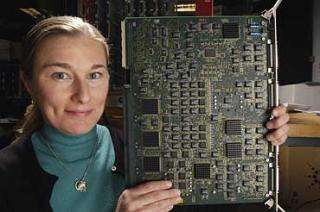World’s fastest image processor aids search for elusive form of matter

If there is a need for speed at the edge of science, that need is arguably greatest among high-energy physicists.
In their world, proton particles, for example, are sent racing around giant accelerators at nearly the speed of light to collide with other particles to create yet more particles. It is the new particles created by the crashing protons that scientists are intensely interested in, as they may well permit researchers to drill down to the true fundamental units of nature and sample conditions that existed right after the Big Bang some 15 billion years ago, when mass and energy were almost infinitely compressed.
But how do scientists study those particle-collision events and the newly created but ephemeral particles that result? The answer, according to a team of UW-Madison scientists, is you build the world’s fastest digital camera.
Now nearing completion in the physics department is a device known to scientists by the off-putting moniker “Regional Calorimeter Trigger.” What the device really is, however, is the world’s fastest image processor, a camera of sorts that can analyze a billion proton collisions per second and, of those, gather digitized data sets for 50,000 events that have some “interesting physics.”
The $6 million device is to be installed as a component of the Compact Muon Solenoid experiment, one of the detectors on the Large Hadron Collider (LHC) in Geneva, Switzerland, a massive collider composed of superconducting magnets 27 kilometers in circumference that is scheduled to begin blasting proton against proton in 2007.
The Large Hadron Collider is at the heart of physicists’ quest to find the Higgs-Boson, an elusive particle that scientists need to understand how particles acquire mass, according to Pamela Klabbers, a UW-Madison scientist leading the effort to build the superfast image processor.
The Higgs-Boson “is one of the last particles we need to complete the standard model of physics,” says Klabbers of the well-established model physicists use to explain the behaviors and properties of the smallest units of matter. Scientists have been seeking definitive evidence of the Higgs-Boson for 20 years.
When protons crash in a collider, an event that occurs over the span of two-billionths of second, the particles they create are so short lived that they cannot be observed directly.
In the LHC, each pair of colliding protons flying around the collider crashes with the energy of about 14 buzzing mosquitoes — but all that energy is compressed into two protons, which are a million times smaller than that annoying bug.
“The power resulting from these collisions is 11,000 watts,” Klabbers explains. “The protons disintegrate in the collision and all that energy creates new particles.”
All of this happens, says Klabbers, in less than two billionths of a second, and scientists need to determine if that ephemeral moment is of interest and record it. That’s where the Regional Calorimeter Trigger comes in.
“We have produced a system to tell us if an interesting collision has occurred and we can effectively take a ‘snapshot’ of that collision and help make a decision to save the information about the collision.”
Because the amount of data that could be collected is so vast, with images arriving every 25 nanoseconds (a nanosecond is a billionth of a second), the system needs to perform serious triage to decide to save or discard an event, says Wesley H. Smith, a professor of physics.
“Besides the huge amount of digital information processed, what is also interesting is that the billions of collisions not selected by this device are lost forever,” says Smith. “There is little room for error and no room for recovery.”
The elusive Higgs-Boson particle that might be created in the proton collisions lasts for the briefest of moments, notes Klabbers: “We look for its byproducts, actually, because it is so short-lived.”
It can decay into photons or muons, other easier to capture but diagnostic particles, she says.
“It has a lot of ways it can decay. Some are easier to detect than others. We’ll look for photons (ordinary light particles), basically. We’ll look to see if they are high energy and we’ll look for energy deposited” as some of the energy from the collisions is, as Einstein so famously stated in his E=mc2 equation, converted to mass.
The Regional Calorimeter Trigger will be capable of processing 4 trillion bits of information per second, in essence taking “a picture of the structure of the collisions 40 million times per second,” says Klabbers, who has been working to build the device at UW-Madison with 20 other people for the past five and a half years.
The Regional Calorimeter Trigger is composed mostly of custom-designed and built circuit boards integrated into crate-like structures that will be in a series of racks 8 to 9 feet tall. The components are scheduled to be shipped to Geneva in June and should be up and running by the end of 2006 in anticipation of the LHC’s first experiments planned for 2007.
For Klabbers, who spends most of her time in Switzerland, it won’t be possible to relax until the first working tests of the Regional Calorimeter Trigger show that it will work as advertised: “Until I see everything working right, I will be apprehensive.”
Source: University of Wisconsin (by Terry Devitt)



















